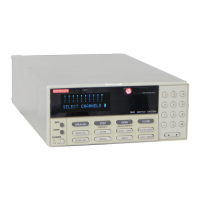Getting Started
3-21
:ARM:LAYER2:SOURCE MANUAL
:ARM:LAY2:SOUR MAN
:arm:layer2:source manual
:arm:lay2:sour man
:Arm:Lay2:Sour Man
:ArM:LaY2:SouR MaN
Parameters
As previously mentioned, a parameter is separated
from the command word by a space. The parameter
can consist of one or more data types such as channel
list, real, integer, string, name or boolean. Examples:
1. :open (@ 1!1, 1!2)
2. :open all
3. :scan (@ 1!1:1!10)
4. :trigger:count:auto on
5. :trigger:delay 0.5
1. (@ 1!1, 1!2) This list parameter is used to specify
a Channel List. Parentheses ( ) are used to enclose
the list of channels. The @ symbol must precede the
first channel in the list. The exclamation point (!) is
a SCPI delimiter used to separate the slot number
from the card relay number. Each channel in the
list must be separated by a comma (,).
2. All This name parameter can instead be used as
the parameter for the :OPEN command if you wish
to open all channels.
3. (@ 1!1:1!10) This list parameter is used to specify
a Scan List. This is the same type of parameter used
in Example 1. In this example, Channels 1 through
10 are specified. Notice that the colon (:) is used as
a separator for the range limits.
4. On This boolean parameter is used to enable an
automatic scan list count. A “1” could have instead
been used. “Off” or “0” will disable the function.
5. 0.5 This real number parameter sets the delay
period in seconds.
Multiple commands
Multiple commands can be sent in the same message as
long as they are separated by semicolons (;). For exam-
ple:
Instead of sending...
:system:error?
:system:preset
You can send ...
:system:error?;preset
When the above message is sent, the first command
word is recognized as the root command. When the
path pointer sees the colon (:) after the semicolon (;), it
resets to the root and starts over.
Proper use of the path pointer allows commands in the
same command level to be serviced without having to
re-type the entire command path. For example, the
command :ARM:LAYer2:SOURce MANual moves the
path pointer down to the last command level in the
path. As a result, the :COUNt, :DELay, and :TIMer
commands and their companion query commands can
be included in the same program message without re-
peating the entire path. Examples:
Instead of sending...
:arm:lay2:sour man;:arm:lay2:sour?
You can send ...
:arm:lay2:sour man;sour?
Instead of sending...
:trig:coun 1;:trig:del 1;:trig:tim 1
You can send ...
:trig:coun 1;del 1;tim 1
Notice that the colon (:) for the additional commands is
not included. Remember, when a colon (not preceeded
by a semicolon) is seen, the path pointer moves down
to the next command level. For example:
:trig:del 1;coun:auto on
When this message is sent, the path pointer moves
down one command level for the DELAY and COUNT
commands. The colon after the COUNT command
then moves the pointer down to the next command
level and enables AUTO.
Artisan Scientific - Quality Instrumentation ... Guaranteed | (888) 88-SOURCE | www.artisan-scientific.com

